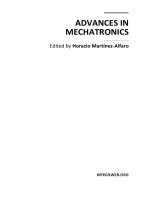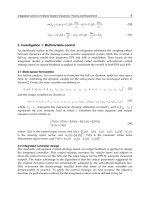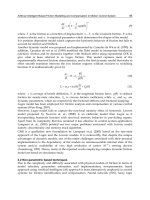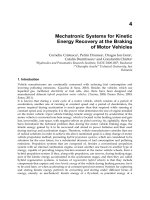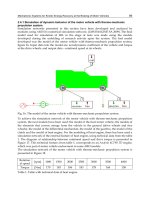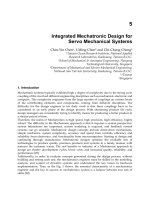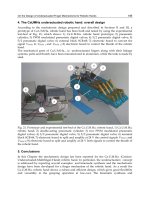Advances in Mechatronics Part 9 ppt
Bạn đang xem bản rút gọn của tài liệu. Xem và tải ngay bản đầy đủ của tài liệu tại đây (1.31 MB, 20 trang )
On the Design of Underactuated Finger Mechanisms for Robotic Hands
149
4. The CaUMHa underactuated robotic hand: overall design
According to the mechatronic design proposed and described in Sections II and III, a
prototype of Ca.U.M.Ha. robotic hand has been built and tested by using the experimental
test-bed of Fig. 21, which shows: 1) Ca.U.M.Ha. robotic hand prototype; 2) pneumatic
cylinder; 3) PWM modulated pneumatic digital valves; 4) 3/2 pneumatic digital valve; 5)
5/2 pneumatic digital valve; 6) external block SCB-68; 7) electronic board to convert the
signal V
PWM
to V
PWM 1
and V
PWM 2
; 8) electronic board to control the thumb of the robotic
hand.
The mechanical parts of Ca.U.M.Ha., i.e. underactuated fingers along with their linkage
systems, palm and thumb, have been manufactured in aluminum, while the tank is made by
steel.
Fig. 21. Prototype and experimental test-bed of the Ca.U.M.Ha. robotic hand, 1) Ca.U.M.Ha.
robotic hand; 2) double-acting pneumatic cylinder; 3) two PWM modulated pneumatic
digital valves; 4) 3/2 pneumatic digital valve; 5) 5/2 pneumatic digital valve; 6) terminal
block SCB-68; 7) electronic board to split and amplify at 24 V the control signals V
PWM 1
and
V
PWM 2
; 8) electronic board to split and amplify at 24 V both signals to control the thumb of
the robotic hand.
5. Conclusions
In this Chapter the mechatronic design has been reported for the Ca.U.M.Ha. (Cassino-
Underactuated-Multifinger-Hand) robotic hand. In particular, the underactuation concept
is addressed by reporting several examples and kinematic synthesis and the mechatronic
design have been developed for a finger mechanism of the robotic hand. As a result the
Ca.U.M.Ha. robotic hand shows a robust and efficient design, which gives good flexibility
and versatility in the grasping operation at low-cost. The kinematic synthesis and
Advances in Mechatronics
150
optimization of the underactuated finger mechanism of Ca.U.M.Ha. have been formulated
and implemented. In particular, two function-generating four-bar linkages and one offset
slider-crank mechanism have been synthesized by using the Freudenstein’ equations and
optimizing the force transmission, which can be considered as a critical issue because of the
large rotation angles of the phalanxes. A closed-loop pressure control system through PWM
modulated pneumatic digital valves has been designed and experimentally tested in order
to determine and analyze its static and dynamic performances. The proposed and tested
closed-loop control system is applied to the Ca.U.M.Ha. robotic hand in order to control the
actuating force of the pneumatic cylinders of the articulated fingers. Consequently, a force
control of the grasping force has been developed and tested according to a robust and low-
cost design of the robotic hand.
6. References
Angeles J., Bernier A., (1987). The Global Least-Square Optimization of Function Generating
Linkages. Journal of Mechanisms, Transmissions and Automation in Design, Vol.109,
pp.204-209.
Arimoto S., (2003). Control for a family of nonlinear and under-actuated systems with DOF-
redundancy and geometric constraints, SICE Annual Conference in Fukui, Fukui,
pp.2205-2210.
Banks J.L. (2001). Design and control of an anthropomorphic robotic finger with multi-point
tactile sensation MS Thesis, MIT, Cambridge.
Beccai L., Roccella S., Ascari L., Valdastri P., Sieber A., Carrozza M. C., Dario P., (2009).
Development and experimental analysis of a soft compliant tactile microsensor for
anthropomorphic artificial hand. IEEE/ASME Transaction on Mechatronics, Vol.13,
no.2, pp.158-168.
Belforte G., Mauro S., Mattiazzo G.(2004). A method for increasing the dynamic
performance of pneumatic servosystems with digital valves, Mechatronics, Vol.14
pp. 1105-1120.
Belforte, G.; Mattiazzo, G.; Mauro, S. & Cocito, C. (2001). A robotic system for apples
harvesting. 10
th
RAAD International Workshop on Robotics in Alpe-Adria-Danube
Region, Vienna, paper: RD-103.
Bicchi A., (2000). Hands for Dexterous Manipulation and Robust Grasping: a Difficult Road
Toward Simplicity. IEEE/ASME Transaction on Robotics and Automation, Vol.16, n.6,
pp.652-662.
Birglen L., Gosselin C.M., (2003). On the Force Capability of Underactuated Fingers.
Proceedings of the 2003 IEEE International Conference on Robotics and Automation, ICRA
2003, Taipei, pp.1139-1145.
Birglen L., Gosselin C.M., (2004). Kinetostatic analysis of underactuated fingers, IEEE
Transactions on Robotics and Automation, Vol.20, n.2 pp. 211-221.
Birglen L., Gosselin C.M., (2005). Fuzzy Enhanced Control of an Underactuated Finger
Using Tactile and Position Sensors. Proceedings of the 2005 IEEE International
Conference on Robotics and Automation, ICRA 2005, Barcelona, pp.2320-2325.
Bulanon, D.M.; Kataoka, T.; Ota, Y. & Hiroma, T. (2001). A machine vision system for the
apple harvesting robot. Agricultural Engineering International: the CIGR J. of Scientific
Research and Development, Vol.3, paper: PM 01 006.
On the Design of Underactuated Finger Mechanisms for Robotic Hands
151
Butterfas J., Grebenstein M.,Liu H., Hirzinger G. (2001). DLR hand II: Next Generation of a
Dextrous Robot Hand. Proceedings of the 2001 IEEE International Conference on
Robotics and Automation, ICRA 2001, Seoul, pp.109-114.
Carrozza M.C., Massa B., Micera S., Lazzarini R., Zecca M. e Dario P. (2002). The
Development of a Novel Prosthetic Hand Ongoing Research and Preliminary
Results. IEEE/ASME Transaction on Mechatronics, Vol.7, n.2, pp.108-114.
Casolo F., Lorenzi V., (1990). Criteri di scelta e Ottimizzazione di Modelli per la Simulazione
del Dito Umano. X Congresso Nazionale dell'Associazione Italiana di Meccanica Teorica
ed Applicata (AIMETA-90), Pisa, pp.415-420.
Chevallereau C., Grizzle J.W., Moog C.H., (2004). Non Linear Control of Mechanical
Systems with One Degree of Underactuation. Proceedings of the 2004 IEEE
International Conference on Robotics and Automation, ICRA 2004, New Orleans,
pp.2222-2228.
Crisman J.D., (1996). Robot Arm End Effector, 1996. US Patent n. 5570920.
Figliolini G., Ceccarelli M. (2002) A novel articulated mechanism mimicking the motion of
index fingers, Robotica, Vol.20, pp.13-22.
Figliolini G., Rea P.(2003) Ca.U.M.Ha. robotic hand for harvesting horticulture products,
XXX CIOSTA - CIGRV Congress on Management and Technology Applications to
Empower and Agro-Food Systems, Turin, pp.288-295.
Figliolini, F. & Rea, P. (2004). Actuation Force Control of Ca.U.M.Ha. Robotic Hand Through
PWM Modulated Pneumatic Digital Valves. 3
rd
FPNI - PhD Symposium on Fluid
Power, Terrassa, pp. 149-156.
Figliolini, G. & Rea, P. (2005). Synthesis and optimization of an underactuated finger
mechanism, Proceedings of the 9th IFToMM Symposium on Theory of Machines and
Mechanisms (SYROM’05), Bucharest, Vol.3, pp. 747-752.
Figliolini, G. & Rea, P. (2006). Overall design of Ca.U.M.Ha. robotic hand, Robotica, Vol.24
n.3, pp. 329-331.
Figliolini G. & Rea, P. (2007). Ca.U.M.Ha. Robotic Hand (Cassino-Underactuated-
Multifinger-Hand). Proceedings of the 2007 IEEE/ASME International Conference on
Advanced Intelligent Mechatronics (AIM2007), Zurich, paper number 250.
Figliolini G., Rea P., Principe M.(2003). Mechatronic design of Ca.U.M.Ha (Cassino-
Underactuated-Multifinger-Hand), 12th RAAD Workshop on Robotics in Alpe-Adria-
Danube Region, Cassino, paper: 026RAAD03.
Francisco J. V. C., (2000). Applying principles of robotics to understand the biomchanics,
neuromuscolar control and clinical rehabilitation of human digits. Proceedings of the
2000 IEEE International Conference on Robotics and Automation, ICRA 2000, San
Francisco, pp.270-275.
Freudenstein F.,(1955). Approximate synthesis of four-bar linkages, Transactions of the
ASME, Vol. 77, pp.853-861.
Gokhale K., Kawamura A. and R.G. Hoft, (1987).Dead beat microprocessor control of PWM
inverter for sinusoidal output waveform synthesis IEEE/ASME Transaction on
Industry application, Vol.1A 23, no.5, pp.901-910.
Gosselin C., Angeles J., (1989). Optimization of Planar and Spherical Function Generators as
Minimum-Defect Linkages. Mechanism and Machine Theory, Vol.24, pp.293-307.
Advances in Mechatronics
152
Haulin E.N., Lakis A.A., Vinet R., (2001). Optimal Synthesis of a Planar Four-Link
Mechanism used in a Hand Prosthesis, Mechanism and Machine Theory, Vol.36,
pp.1203-1214.
Haulin E.N., Vinet R., (2003). Multiobjective Optimization of Hand Prothesis Mechanisms
Mechanism and Machine Theory, Vol.38, pp.3-26.
Imai Y., Namiki A., Hashimoto K., Ishikawa M., (2004). Dynamic Active Catching Using a
High-speed Multi¯ngered Hand and a High-speed Vision System. Proceedings of the
2004 IEEE International Conference on Robotics and Automation, ICRA, New Orleans,
pp.1849-1854.
Jiang L., Sun D. and Liu H., (2009). An inverse-kinematics table-based solution of a
humanoid robot finger with nonlinearly coupled joints IEEE/ASME Transaction on
Mechatronics, Vol.14, n.3, pp.273-281.
Jacobsen, S.C.; Wood, J.E.; Knutti, D.F. & Biggers, K.B. (1984). The Utah/MIT dexterous
hand: work in progress, The Int. J. of Robotics Research, Vol.3, No.4, pp. 21-50.
Jobin J.P., Buddenberg H.S., Herder J.L., (2004). An Underactuated Prothesis Finger
Mechanism with Rolling Joints. Proceedings of DETC ASME, 28th Biennal Mechanisms
Conference, Salt Lake City,
Kim K., Edward Colgate J., Santos-Munné J.J., Makhlin A. and Peshkin M., (2010). On the
design of miniature haptic devices for upper extremity prosthetics. IEEE/ASME
Transaction on Mechatronics, Vol.15, n.1, pp.27-39.
Lalibertè, T., Gosselin, C.M. (1998). Simulation and design of underactuated mechanical
hands. Mechanism and Machine Theory, Vol.33, No.1, pp.39-57.
Lalibertè T., Birglen L., Gosselin C.M. (2002). Underactuation in robotic grasping hands,
Japanese Journal of Machine Intelligence and Robotic Control, Vol.4, n.3 pp.77-87.
Lee H.J., Yi B.J., Oh S.R., Suh I.H., (2001). Optimal Design and Development of a Five-Bar
Finger with Redundant Actuation, Mechatronics, Vol. 11, pp.27-42.
Liu, H.; Butterfass, J.; Knoch, S.; Meisel, P. & Hirzinger, G. (1999). A new control strategy for
DLR’s multisensory articulated hand. IEEE Control systems, Vol.19, n.2, pp.47-54.
Liu G. and Li Z., (2004). Real time grasping-force optimization for multifingered
manipulation: Theory and experiments IEEE/ASME Transaction on Mechatronics,
Vol.9, n.1, pp.65-77.
Liu H., Meuse P., Hirzinger G., Jin M., Liu Y., and Xie Z. (2008).The modular multisensory
DLR-HIT-hand: Hardware and software architecture IEEE/ASME Transaction on
Mechatronics, Vol.13, n.4, pp.461-469.
Liu H., Wu K., Meusel P., Seitz N., Hirzinger G., Jin M.H., Liu Y.W., Fan S.W., Lan T. and
Chen Z.P. (2008). Multisensory five-finger dexterous hand: The DLR/HIT hand II
IEEE/RSJ International Conference on Intelligent Robots and Systems. Acropolis
Convention Center Nice, Sept, 22-26.
Lotti F., Tiezzi P., Vassura G., Biagiotti L., Melchiorri C., Palli G., (2004). UBH 3: A
Biologically Inspired Robotic Hand. Proc. of IEEE International Conference on
Intelligent Manipulation and Grasping (IMG 04), Genova, pp. 39-45.
Luo M., Mei T., Wang X., Yu Y., (2004). Grasp Characteristics of an Underactuated Robot
Hand. Proceedings of the 2004 IEEE International Conference on Robotics and
Automation, ICRA 2004, New Orleans, (USA), pp.2236-2241.
Mason M. T., Salisbury J.K., (1984). Robot hand and the mechanics of manipulation, Tokyo,
pp.151-167.
On the Design of Underactuated Finger Mechanisms for Robotic Hands
153
Mason, M.T. & Salisbury, J.K. (1985). Robot Hand and the Mechanics of Manipulation, MIT
Press, Cambridge, MA.
Montambault, S. & Gosselin, C.M. (2001). Analysis of underactuated mechanical grippers.
ASME J. of Mechanical Design, Vol.123, n.3, pp. 39-57.
Namiki A., Imai Y., Ishikawa M., Kaneko M. (2003). Development of a High-Speed
Multifingered Hand System and Its Application to Catching. Proceedings of the 2003
IEEE/RSJ Intl. Conference on Intelligent Robots and Systems, Las Vegas, pp.2666-2671.
Raparelli, T.; Mattiazzo, G. & Mauro, S., Velardocchia M. (2000). Design and development of
a pneumatic anthropomorphic hand. J. of Robotic Systems, Vol.17, n.1, pp. 1-15.
Rash G.S., Belliappa P.P., Wachowiak M.P., Somia N.N., Gupta A., (1999). A Demon-stration
of the Validity of a 3-D Video Motion Analysis Method for Mesuring Finger Flexion
and Extension, Journal of Biomechanics, 32, pp.1337-1341.
Rea P., (2007). Mechatronic Design of underactuated robotic hand with pneumatic actuation,
Ph.D. Dissertation, University of Cassino, Cassino. Available at:
XIX/TesiRea.pdf
Schultz S., Pylatiuk C., Bretthauer G., (2001). A New Ultralight Anthropomorphic Hand.
Proceedings of the 2001 IEEE International Conference on Robotics and Automation, ICRA
2001, Seoul, (Korea), pp.2437-2441.
Schweizer A., Frank O., Ochsner P.E., Jacob H.A.C., (2003). Friction Between human Finger
Tendons and Pulleys at High loads, Journal of Biomechanics, 36, pp.63-71.
Sorli M., Figliolini G., Pastorelli S., Modeling and experimental validation of a two-way
pneumatic digital valve, Bath Workshop on Power Transmission & Motion Control, Eds.
C.R. Barrows and K.A. Edge, Professional Engineering Publishing, London, 2003,
pp.291-305.
Sorli M., Figliolini G. and Pastorelli S., (2004). Dynamic model and experimental
investigation of a pneumatic proportional pressure valve. IEEE/ASME Transaction
on Mechatronics, Vol.9, n.1, March 2004, pp.78-86.
Su F-C., Kuo L.C., Chiu H.Y., Chen-Sea M.J., (2003). Video-Computer Quantitative
Evaluation of Thumb Function using Workspace of the Thumb. Journal of
Biomechanics, Vol.36, pp.937-942.
Salisbury J. K., Craig J. J., (1981). Articulated Hands: Force Control and Kinematic Issues.
Joint Automatic Control Conference, Charlottesville, pp.17-19.
Sutherland G., Roth B., (1973). A Transmission Index for Spatial Mechanisms. ASME Journal
of Engineering Industry, pp.589-597.
Stellin G., Cappiello G., Roccella S., Carrozza M.C., Dario P., Metta G., Sandini G., Becchi F.,
(2006). Preliminary Design of an Anthropomorphic Dexterous Hand for a 2-Years-
Old Humanoid: Towards Cognition. The First IEEE/RAS-EMBS International
Conference on Biomedical Robotics and Biomechatronics, pp.290-295.
Taylor C.L., Schwartz R.J., (1955). The Anatomy and Mechanics of the Human Hand.
Artificial Limbs, Vol.2 pp.22-35.
Van Varseveld R. B. and Bone G. M.,(1997). Accurate position control of a pneumatic
actuator using On/Off solenoid valves IEEE/ASME Transaction on Mechatronics,
Vol.2, n.3, pp.195-204.
Wenzeng Z., Chen Q., Sun Z., Khao D., (2004). Passive Adaptive Grasp Multi-Fingered
Humanoid Robot Hand with High Under-actuated Function. Proceedings of the 2004
Advances in Mechatronics
154
IEEE International Conference on Robotics and Automation, ICRA 2004, New Orleans,
pp.2222-2228.
Yamano I., Maeno T., (2005). Five Fingered Robot Hand using Ultrasonic Motors and Elastic
Elements. Proceedings of the 2005 IEEE International Conference on Robotics and
Automation, pp.2673-2678.
Yuan X., Stemmler H. and I. Barbi (2001).Self-balancing of the clamping-capacitor-voltages
in the multilevel capacitor-clamping-inverter under sub-harmonic PWM
modulation IEEE/ASME Transaction on Power Electronics, Vol.16, n.2, pp.256-263.
Yun M.H., Eoh H.J., Cho J., (2002). A Two Dimensional Dynamic Finger Modeling for the
Analysis of Repetitive Finger Flexion and Extension, Journal of Industrial Ergonomics,
Vol.29, pp.231-248.
7
Robotic Grasping and Fine Manipulation
Using Soft Fingertip
Akhtar Khurshid
1
, Abdul Ghafoor
2
and M. Afzaal Malik
1
1
College of Electrical and Mechanical Engineering, Rawalpindi, National University of
Sciences and Technology, H-12, Islamabad,
2
School of Mechanical and Manufacturing Engineering, National University of Sciences
and Technology, H-12, Islamabad,
Pakistan
1. Introduction
The ability to create stable, encompassing grasps with subsets of fingers is greatly increased
by using soft fingertips that deform during contact and apply a larger space of frictional
forces and moments than their rigid counterparts. This is true not only for human grasping,
but also for robotic hands using fingertips made of soft materials.
The superiority of deformable human fingertips as compared to hard robot gripper fingers
for grasping and manipulation has led to a number of investigations with robot hands
employing elastomers or materials such as fluids or powders beneath a membrane at the
fingertips.
When the fingers are soft, during holding and for manipulation of the object through precise
dimensions, their property of softness maintains the area contact between, the fingertips and
the manipulating object, which restraints the object and provides stability. In human finger
there is a natural softness which is a combination of elasticity and damping. This
combination of elasticity and damping is produced by nature due to flesh and blood
beneath the skin. This keeps the contact firm and helps in holding the object firmly and
stably.
2. Background
Over the past several decades, object manipulation and grasping by robot hands has been
widely studied [1–7]. Multifingered-hand research has focused on grasping control [8] and
visual and tactile control [9]. Grasp-less manipulation [10], i.e., manipulation without hand
grasping and power grasping [11] using the palm of the robot hand have also been
proposed. These studies assume that fingertips and manipulated objects are rigid, making
point contact, and have analyzed manipulation as quasi-static. Such assumptions are useful
for kinematic and static analysis of robot finger grasping and manipulation, but rarely apply
in actual dynamic grasping and manipulation. Manipulation and grasping by soft fingertips
contribute to grasping stability due to the area of contact and high friction involved.
One approach to investigate in this area is by first analyzing the stability of dynamic
control of an object grasped between two soft fingertips through a soft interface using the
Advances in Mechatronics
156
viscoelastic material between the manipulating fingers and a manipulated object and then
modeling it through bond graph method (BGM). The fingers are made viscoelastic by using
springs and dampers. Detailed bond graph modeling of the contact phenomenon with two
soft-finger contacts considered to be placed against each other on the opposite sides of the
grasped object as is generally the case in a manufacturing environment is made. The
viscoelastic behavior of the springs and dampers is exploited in order to achieve the stability
in the soft-grasping which includes friction between the soft finger contact surfaces and the
object. This work also analyses stability of dynamic control through a soft interface between
a manipulating finger and a manipulated object. It is shown in this work that the system
stability depends on the viscoelastic material properties of the soft interface. Method of root
locus is used to analyze this phenomenon.
Ultimate objective of this work is to design and develop a robotic gripper which has soft
fingers like human fingers. Soft fingers have ability to provide area contact which helps in
dexterous grasping, stability and fine manipulation of the gripping object.
Robotics is gaining new and extensive application fields, becoming pervasive in the daily
life. Manipulation skills at macro and micro scale are very important requirements for the
emergent robot applications, both in industry (e.g. handling food, fabrics, leather) and in
less structured domains (e.g. surgery, space, undersea). The manipulation and grasping
devices and systems are a vital part of industrial, service and personal robotics for various
applications and environments to advance manufacturing automation, to make safe
hazardous operations and to enhance in different ways to the living standards.
The human hand which has the three most important functions: to explore, to restrain
objects, and to manipulate objects with arbitrary shapes (relative to the wrist and to the
palm) is used in a variety of ways [12]. The first function falls within the realm of haptics, an
active research area in its own merits [13]. My work does not attempt an exhaustive
coverage of this area. This work in robotic grasping is to understand and to emulate the
other two functions. The task of manipulating objects with fingers (in contrast to
manipulation with the robot arm) sometimes is called dexterous manipulation. This work
will be fascinated with constructing mechanical analogues of human hands and will lead us
to place all sorts of hopes and expectations in robot capabilities.
Probably the first occurrence of mechanical hands was in prosthetic devices to replace lost
limbs. Almost without exception prosthetic hands have been designed to simply grip objects
[14]. In order to investigate the mechanism and fundamentals of restraining and
manipulating objects with human hands, later a variety of multifingered robot hands are
developed, such as the Stanford/JPL hand [14], the Utah/MIT hand [15], and other hands.
Compared to conventional parallel jaw grippers, multifingered robot hands have three
potential advantages: (1) they have higher grip stability due to multi-contact points with the
grasped object; (2) they can grasp objects with arbitrary shapes; (3) it is possible to impart
various movements onto the grasped object. However, multifingered robot hands are still in
their infancy. In order for the multifingered robot hands to possess the properties so that
robots implement autonomously the tasks of grasping in industry, it is necessary to study
the planning methods and fundamentals of robotic grasping as well.
The vast majority of robots in operation today consist of six-jointed “arms” with simple
hands or “end effectors” for grasping objects. The applications of robotic manipulations
range from pick and place operations, to moving cameras and other inspection equipment,
to performing delicate assembly tasks. They are certainly a far cry from the wonderful fancy
about the stuff of early science fiction, but are useful in such diverse arenas as welding,
Robotic Grasping and Fine Manipulation Using Soft Fingertip
157
painting, transportation of materials, assembly of printed circuit boards, and repair and
inspection in hazardous environments [14, 16].
The hand or end effector is the bridge between the manipulator (arm) and the environment.
The traditional mechanical hands are simple, out of anthropomorphic intent. They include
grippers (either two- or three-jaw), pincers, tongs, as well as some compliance devices. Most
of these end effectors are designed on an ad hoc basis to perform specific tasks with specific
tools. For example, they may have suction cups for lifting glass which are not suitable for
machined parts, or jaws operated by compressed air for holding metallic parts but not
suitable for handling fragile plastic parts. Further, a difficulty that is commonly encountered
in applications of robotic manipulations is the clumsiness of a robot equipped only with
these simple hands, which is embodied in lacking of dexterity because simple grippers
enable the robot to hold parts securely but they cannot manipulate the grasped object,
limited number of possible grasps resulting in the need to change end effectors frequently
for different tasks, and lacking of fine force control which limits assembly tasks to the most
rudimentary ones [16].
3. Gripper
Any mechanism which can grasp different objects is called as gripper. It is actually a
subsystem of handling mechanism which provides a temporary contact with the object to be
grasped. The Gripper ensures that the position and the orientation of the object that is
grasped are constrained enough so that the process of carrying, joining etc is done
efficiently. This term “gripper” is also used where no actual grasping, rather holding of the
object for example in vacuum suction takes place. [17]
4. Classification
Grippers can be classified on the basis of various aspects ranging from type of grasping to
number of fingers as discussed below:
4.1 Classification on basis of type of contact
There are three basic types of grippers on the basis of type of contact, shown in figure 1:
- Point Contact
- Line Contact
- Area Contact
4.1.1 Point contact
As the name indicates, point contact gripping takes place when the gripping fingers and the
object to be grasped come in contact at some particular points. In this type of gripping there
are at least three to four points of contact between the gripping fingers and the object to be
grasped.
4.1.2 Line contact
In line contact the contact between the gripper jaw / finger takes place in the form of a line
which is dependent on the shape of the object. In Line Contact one has to make sure that the
hypothetical lines which are formed during contact are parallel or as close to parallel as
possible otherwise proper grasping becomes far too difficult.
Advances in Mechatronics
158
4.1.3 Area contact
Instead of points or lines, there is a whole surface area of the fingers that is coming in
contact with the object. Generally in area contact, contact of two surface areas from opposite
sides is enough to completely constrain the object.
Fig. 1. Types of contacts, their pressure force and the general gripper jaw shape. [18]
Where:
F
k
= Contact Force
E
r
= (2*E
t
*E
s
)/(E
t
+ E
s
)
E
t
= Young’s Modulus of object
E
s
= Young’s Modulus of gripper finger/Jaw.
4.2 Classification on basis of number of fingers
On the basis of number of fingers, grippers can be classified into two, three, four, and more
number of fingers:
Robotic Grasping and Fine Manipulation Using Soft Fingertip
159
4.2.1 Two finger grippers
Two finger grippers only have two fingers by which they grasp the object. These types of
grippers have generally area contact because they generally due to the shape of the fingers
cannot give more than two points of contact and as discussed before, this is not enough to
grasp the object firmly and to constrain its degrees of freedom.
4.2.2 Three finger grippers
Due to the fact that the gripper has three fingers, it can have both area and surface contact.
But the usage of three fingers in grasping also increases the design complexity and the
complexity of the control that must be developed for it.
4.2.3 Four finger grippers
Four Finger Grippers are sometimes a combination of two finger grippers and at other times
a combination of independent fingers working together. These grippers are used in
relatively high cost and precision demanding applications.
4.2.4 Five finger grippers
These grippers are developed purely on research basis to make the grasping dexterous
(closer to human hand gripping approach). There are grippers with more than five fingers
as well.
4.3 Classification on the basis of gripping method
There are basically four types of grippers on the basis of their gripping method. Table 1
shows the types of gripping methods along with the non-penetrating and the penetrating
examples.
Table 1. Table of Gripping methods along with the non-penetrating and the penetrating
examples. [19]
Advances in Mechatronics
160
4.3.1 Impactive grippers
Impactive Grippers make the use of impact of jaws and the object to be grasped through the
motion of solid jaws in order to produce the necessary grasping force.
4.3.2 Ingressive grippers
Ingressive grippers deform or penetrate the surface to some predefined depth (force shape
mating).
4.3.3 Contigutive grippers
Contigutive type of gripping means that there is a direct contact to facilitate the gripping.
For example: chemical adhesion.
4.3.4 Astrictive grippers
Astrictive grippers make use of the binding forces between the surfaces. For example:
magnets or electrostatic adhesion. Some of these types of grippers do not even have physical
contact with the grasped object.
4.3.5 Importance of gripper
The end effector that is usually used by the manipulator is the gripper. There are a lot of
Grippers having different mechanisms and design that exist in the industry. Grippers
essentially replace most of the work that is done by the human hand. If the gripping abilities
of a mechanical five-finger "hand" are denoted as 100%, then a four-finger hand has 99% of
its ability, a three-finger hand about 90%, and a two-finger hand 40%.
4.4 Taxonomy of common end effectors
Nowadays Robotic end effectors include everything from simple two-fingered grippers and
vacuum attachments to elaborate multi fingered hands. Perhaps the best way to become
familiar with end effector design issues is to first review the main end effector types.
Figure 2 is taxonomy of common end effectors. It is inspired by an analogous taxonomy of
grasps that humans adopt when working with different kinds of objects and in tasks
requiring different amounts of precision and strength .The left side includes “passive”
grippers that can hold parts, but cannot manipulate them or actively control the grasp force.
The right-hand side includes active servo grippers and dexterous robot hands found in
research laboratories and teleoperated applications.
4.4.1 Passive end effectors
Most end effectors in use today are passive; they emulate the grasps without manipulating it
in the fingers. However, a passive end effector may (and generally should) be equipped
with sensors, and the information from these sensors may be used in controlling the robot
arm. The left-most branch of the “passive” side of the taxonomy includes vacuum,
electromagnetic, and Bernoulli-effect end effectors. Vacuum grippers, either singly or in
combination, are perhaps the most commonly used gripping device in industry today. They
are easily adapted to a wide variety of parts from surface mount microprocessor chips and
other small items that require precise placement to large, bulky items such as automobile
windshields and aircraft panels. These end effectors are classified as “no prehensile”
because they neither enclose parts nor apply grasp forces across them. Consequently, they
Robotic Grasping and Fine Manipulation Using Soft Fingertip
161
Fig. 2. A taxonomy of the basic end effector types. [20]
are ideal for handling large and delicate items such as glass panels. Unlike grippers with
fingers, vacuum grippers do not tend to “center” or relocate parts as they pick them up. If
difficulties are encountered with a vacuum gripper, it is helpful to remember that problem
can be addressed in several ways, including increasing the suction cup area through larger
cups or multiple cups, redesigning the parts to be grasped so that they present a smoother
surface (perhaps by affixing smooth tape to a surface), and augmenting suction with
grasping. The second branch of end effector taxonomy includes “wrap” grippers that hold a
part in the same way that a person might hold a heavy hammer or a grapefruit. In such
applications, humans use wrap grasps in which the fingers envelop a part, and maintain a
nearly uniform pressure so that friction is used to maximum advantage.
Another approach to handling irregular or soft objects is to augment a vacuum or magnetic
gripper with a bladder containing particles or a fluid. When handling ferrous parts, one can
employ an electromagnet and iron particles underneath a membrane. Still another approach
is to use fingertips filled with an electro rheological fluid that stiffens under the application
of an electrostatic field. The middle branch of the end effector taxonomy includes common
two-fingered grippers. These grippers employ a strong “pinch” force between two fingers,
in the same way that a person might grasp a key when opening a lock. Most such grippers
are sold without fingertips since they are the most product-specific part of the design. The
Advances in Mechatronics
162
fingertips are designed to match the size of components, the shape of components (e.g., flat
or V-grooved for cylindrical parts), and the material (e.g., rubber or plastic to avoid
damaging fragile objects). Note that since two-fingered end effectors typically use a single
air cylinder or motor that operates both fingers in unison, they will tend to center parts that
they grasp. This means that when they grasp constrained parts (e.g., pegs that have been set
in holes or parts held in fixtures) some compliance must be added. [21]
4.4.2 Active end effectors and hands
The right-hand branch of the taxonomy comprises of servo grippers and dexterous multi
fingered hands. Here the distinctions depend largely on the number of fingers and the
number of joints or degrees of freedom per finger. For example, the comparatively simple
two-fingered servo gripper is confined to “pinch” grasps, like commercial two-fingered
grippers, shown in figure 3:. Servo-controlled end effectors provide advantages for fine-
motion tasks. In comparison to a robot arm, the fingertips are small and light, which means
that they can move quickly and precisely. The total range of motion is also small, which
permits fine-resolution position and velocity measurements. When equipped with force
sensors such as strain gages, the fingers can provide force sensing and control, typically
with better accuracy than can be obtained with robot wrist or joint-mounted sensors. A
servo gripper can also be programmed either to control the position of an unconstrained
part or to accommodate to the position of a constrained part .The sensors of a servo-
controlled end effector also provide useful information for robot programming. For
example, position sensors can be used to measure the width of a grasped component,
thereby providing a check that the correct component has been grasped. Similarly, force
sensors are useful for weighing grasped objects and monitoring task-related forces which
can help in checking the weights of the objects.
Fig. 3. A two-finger servo gripper with force sensing and changeable fingertips. [3]
Robotic Grasping and Fine Manipulation Using Soft Fingertip
163
For a wide range of applications requiring a combination of dexterity and versatility for
grasping a wide range of objects, a dexterous multi fingered hand is the ultimate solution. A
number of multi fingered hands have been described in the literature and commercial
versions are available. Most of these hands are frankly anthropomorphic, although
kinematic criteria such as workspace and grasp isotropy (basically a measure of how
accurately motions and forces can be controlled in different directions) have also been used.
Despite their practical advantages, dexterous hands have thus far been confined to a few
research laboratories. One reason is that the design and control of such hands present
numerous difficult tradeoffs among cost, size, power, flexibility and ease of control. For
example, the desire to reduce the dimensions of the hand, while providing adequate power,
leads to the use of cables that run through the wrist to drive the fingers. These cables bring
attendant control problems due to elasticity and friction .A second reason for slow progress
in applying dexterous hands to manipulation tasks is the formidable challenge of
programming and controlling them. The equations associated with several fingertips sliding
and rolling on a grasped object are complex, the problem amounts to coordinating several
little robots at the end of a robot. In addition, the mechanics of the hand/object system are
sensitive to variations in the contact conditions between the fingertips and object (e.g.,
variations in the object profile and local coefficient of friction). Moreover, during
manipulation the fingers are continually making and breaking contact with the object,
starting and stopping sliding, etc., with attendant changes in the dynamic and kinematic
equations which must be accounted for in controlling the hand.
When the fingers are soft, during holding and for manipulation of the object through precise
dimensions, their property of softness maintains the area contact between, the fingertips and
the manipulating object, which restraints the object and provides stability. In human finger
there is a natural softness which is a combination of elasticity and damping. This
combination of elasticity and damping is produced by nature by putting flush and blood
beneath the skin. When it holds the object due to the applied force reaction comes according
to 3
rd
law of Newton and presses the skin and when it rotates the object for manipulating,
skin comes back to its original state softly and the other portion compresses against the
object. This keeps the contact firm and helps in holding the object firmly and stably. The
setup shown in figure 4 is an example of such grasping. It is being modeled in figure 5.
Fig. 4. A set up showing two soft fingers grasping a knob.
Advances in Mechatronics
164
To analyze the stability of dynamic control through a soft interface that is the viscoelastic
material between manipulating fingers and a manipulated object, we have to model
dynamic control through the soft interface.
Thus we have to find out:
- How to make the robotic fingers soft?
- The method for measuring the soft fingers grasping force
- Their modeling and simulation
- Analyzing the stability effect due to soft fingers
- Role of springs and dampers in providing stability and accuracy in dexterous
manipulation
We shall show that system stability depends on the viscoelasticity of the soft interface for
feedback control. The relationship between material viscoelastic property and the settling
time shall be analyzed by root locus. Stability analysis is done by using bondgraph
methodology to precisely model the situation and then simulating based on Runge-Kutta
method.
4.5 Work objective
During grasping the weight of the object being grasped is controlled from slipping
downward with the friction between the grasping fingers and the object. This friction
further depends upon the applied force. For securing the object from damaging, the contact
fingers are made soft by introducing springs and dampers at contacts.
Human finger tips are fleshy, soft and deformable. They locally mold to the shape of a
touched or grasped object due to their viscoelastic behavior, and for these reasons, are
capable of extremely dexterous manipulation tasks. Viscoelastic materials have an
interesting mix of material properties that exhibit viscous behavior (like the gradual
deformation of molasses) as well as elasticity (like a rubber band that stretches
instantaneously and quickly returns to its original state once a load is removed). The clearest
way to visualize the behavior of a material containing both elastic and viscous components
is to think of a spring (exerting forces to return to its unstressed state) in series with a
dashpot (a damper that resists sudden motion, similar to the pneumatic cylinder that
prevents a storm door from slamming shut).
Most robot fingers are crude and therefore rather limited in capability. This realization has
led to the investigation of robotic manipulation with soft, human like fingers, for example,
Sun and Howe [22], Trembley and Cutkosky[23], Howe and Cutkosky [24], Russel and
Parkinsan[25], and Shinofa and Goldenburg[26] report on experiments in which either
foam-backed or fluid-filled fingers successfully enhanced dexterous capability. Therefore, in
this work, the robot fingers are made soft by introducing springs and dampers at contact.
Thus by varying the damping and stiffness, control of the grasped object is achieved.
In the first step we put spring and damper to provide this viscoelastic effect in the grasping
finger tips to make the grasping dexterous. Then we made its precise mathematical model
by using BGM and put it in virtual environment. Then by using 20-Sim software we have
studied by modeling and simulation different experiments in virtual environment the
behavior of springs and dampers during grasping. Then we came to this conclusion that by
changing spring stiffness and damping coefficient of damper the object can be grasped
effectively. They influence the friction between the fingers and the object which plays a vital
role in grasping stability. Figure 5 shows this setup.
Robotic Grasping and Fine Manipulation Using Soft Fingertip
165
Fig. 5. Model of two soft fingers grasping the object.
Bond-graph modeling and simulation methodology is an attempt to explore the modeling
intricacies encountered in the system, using an alternative but powerful modeling
technique. The bond graph technique is a graphical representation of the power flow using
bonds. It can be very helpful in the preparation of the equations of motion for digital
simulation. This method is especially powerful when several physical domains have to be
modeled within a system simultaneously. Although the bond graph is of relatively recent
origin, it has been widely used in the simulation of system dynamics.
The bond graph is a graphic language for modeling dynamic systems. It displays, by letter
elements and half arrows, the energy phenomena modeled in a system and the topology of
the energy transfer between these phenomena. The bond graph representation of a system
may be constructed in total abstraction from the mathematical model of the system. Even
the individual phenomena may be graphically represented without considering the
characteristic laws. This constitutes the physical level of the description contained in the
bond graph representation.
A.Khurshid and M A Malik [27-29] have used bond graph techniques for modeling and
simulation of different dynamic systems. Bond-graphs represent the dynamics of the system
pictorially and are extensively used for the modeling of physical system dynamics in
multiple energy domains, as discussed by A.Khurshid and M A Malik [30]. A bond-graph
model is based on the interaction of power between the elements of the system. The cause-
effect relationships help in deriving the system state equations. Further, the model yields
insight into various aspects of the control of the system [31, 32].
The effects due to softness of the finger tips while manipulating an object and due to the
friction at the finger contacts, and their internal damping and stiffness are modeled and
successfully analyzed.
We have modeled dynamic control through a soft interface and formulate system dynamics
through a soft interface represented by continuous-discrete time. Taking as an example force
control based on the linear mass-damper-spring model.
4.6 Modeling the soft interface
Figure 5 shows a simplified model for a soft interface using linear mass-damper-spring
components. The model describes soft robotic fingertips holding an object.
It consists of two fingers which are used to manipulate the objects as done by human
fingers. The two fingers are made soft by introducing linear mass, spring, and damper effects in
Advances in Mechatronics
166
these. Force Sf
a
is applied to both fingers for the grasping of the object. The weight of the
object tries to slip it from the grasping of fingers, whereas the friction between the fingers
contacts surfaces with the object balance it. Friction is represented as damping by R
f
at the
finger’s contact surfaces with the object and two dampers are part of the fingers having
damping R
d
. The stiffness of the springs used in the fingers is K
s
. The mass of the outer
surface layers of the fingers in contact with the object is M
f
. The mass of object is M
o
and its
weight is taken as Se
o
. We have assumed that the soft material shows linear viscoelasticity.
Parameters R
f
, K
s
, and R
d
are time-invariant and positive.
4.7 Bond-graph model and state space equations
The physical system shown in figure 1 is converted into bond graph shown in figure 6. A
bond graph model is a precise mathematical description of the physical system in the sense
that it leads to the state space description of the system.
Fig. 6. The bond graph model of two fingers grasping an object as shown in fig-5.
The bond graph model shown in figure 6 leads to the following state space equations from
1-5 of the soft finger system:
p˙
f
=R
d
*(Sf
a
- p
f
/M
f
) +K
s
*q
s
+R
f
*(- p
f
/M
f
- p
o
/M
o
) (1)
p˙
f
= R
f
*(- p
o
/M
o
- p
f
/M
f
) +K
s
*q
s
+R
d
*(- p
f
/M
f
+Sf
a
) (2)
p˙
o
=R
f
*(- p
f
/M
f
- p
o
/M
o
) +Se
o
+R
f
*(- p
o
/M
o
- p
f
/M
f
) (3)
q˙s=- p
f
/M
f
+Sf
a,
(4)
q˙s= Sf
a
- p
f
/M
f
(5)
The description of different variables and parameters appearing in the above equations is
given below.
p˙
f
= force on finger by the object (N), p˙
o
= force on object by the fingers (N)
q˙s = velocity of spring in finger (m/s), Sf
a
= applied force on finger (m/s)
R
d
= damping in soft finger (Ns/m), R
f
= friction at soft finger contact (Ns/m)
M
f
= mass of finger & M
o
= mass of object (kg),
The state variables are q
s
= displacement of spring (m), p
f
= momentum on finger (kg m/s),
p
o
= momentum on object (kg m/s). Total five state variables, for both the fingers q
s
and p
f
are assumed same.
Se
o
= weight of object (N), K
s
= spring stiffness (N/m)
Robotic Grasping and Fine Manipulation Using Soft Fingertip
167
4.8 Simulation and results
For simulation of the state space equations of the physical system, we have used 20-sim
computer software [33]. The results of grasping the object by soft contact fingers and their
corresponding root locus, based on BGM modeling and simulation are shown in figure 7-9.
The flow signal on each finger is 0.1 m/s.
Fig. 7. The vertical displacement of object vs time adjusting stiffness and corresponding
rootlocus of the dynamic system.
Advances in Mechatronics
168
Fig. 8. The vertical displacement of object vs time adjusting finger damping and
corresponding rootlocus of the dynamic system.
